Barbs and danios in the aquarium
Table of contents
- Barbs
- Barbels - Appearance
- Barbs in the Aquarium - Behaviour
- Aquarium equipment for barbs
- The correct feeding of barbs
- Breeding barbs
- Barbs
- Bearded danios - Appearance
- Bearded danios in the aquarium - behaviour
- Aquarium equipment for danios
- The correct feeding of danios
- Breeding danios
- The most popular types of barbs in aquariums
- The most popular types of danios or rasboras in aquaristics
Barbs
The colourful and varied-looking barbs are sociable fish that live in freshwater. They belong to the carp family (Cyprinidae). Barbs are found almost all over the world, and there are even species in Europe. However, the tropical and subtropical barb species commonly found in aquariums come mainly from Southeast Asia. Among them are colourful schooling fish like the Sumatran barb as well as algae-eating fish like the net brush algae eater and the proboscis barb.
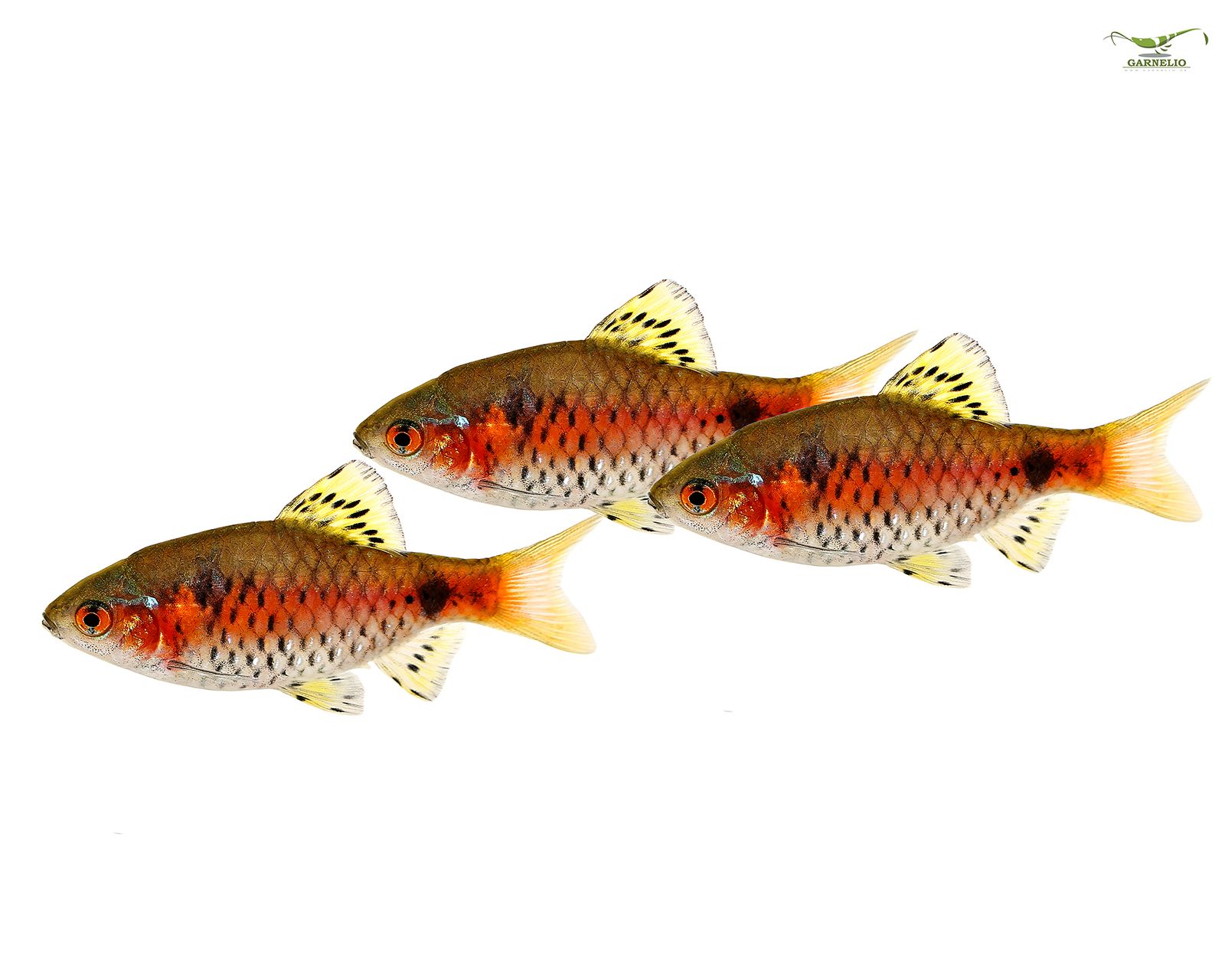
Barbs - Appearance
Many of the barbs in aquaristics have a laterally compressed body shape. They are quite high-backed and, with their large fins and beautifully coloured, eye-catching and often shiny scales, look like the ideal typical fish we remember from the picture books of our childhood. They live in the middle layers of the water. Suckermouth barbs and algae eaters also belong to the barb family. These ornamental fish have a rather elongated body with a flat underside. They have adapted to a life on the bottom as algae eaters.
Barbs in the aquarium - behaviour
The sociable barbs should always be kept as a school of 7-10 animals of the same species or more. However, you can mix different colourings, for example of the Sumatran barb. The morphs still belong to the same species, even if they look different. This way you have a colourful, but still species-appropriate stock in the aquarium. This also applies to the algae-eaters among the barbs.
Barbs have quite intense social behaviour, some of which could be described as quite rowdy and assertive. They are therefore not suitable aquarium mates for shy by-fish or ornamental fish with long or stringy fins. Very small aquarium fish are also not suitable company for the lively, feisty barbs. They are lively and very playful and swim weasel-like. Barbs are great eye-catchers in the aquarium - there is always something going on here! Barbs are relatively undemanding and adaptable and are therefore well suited as aquarium fish for beginners, provided the aquarium is large enough for these lively ornamental fish with their great love of movement.
Most barbs are omnivores. In the wild they hunt and eat insect larvae as well as small crustaceans, so they do not fit well in shrimp aquariums. Barbs that do not live on the bottom, however, fit well with crayfish.
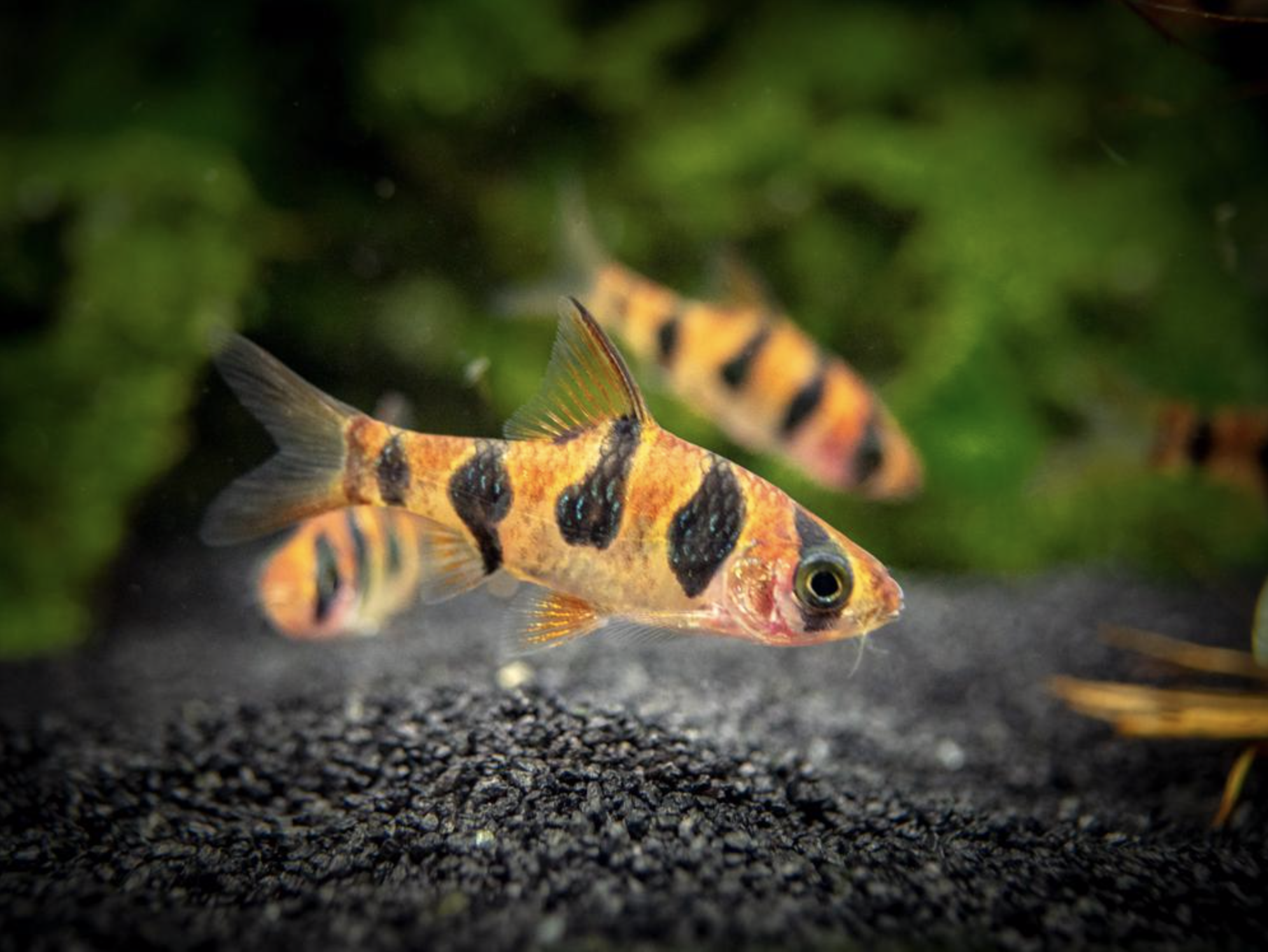
Aquarium setup for barbs
An aquarium for the lively and very lively barbs must be planted so that the colourful ornamental fish have enough swimming space. The planting around the edges can be dense, so that the barbs can hide nicely. The plants should not be too fine-grained, as some barbel species like to pick at soft-leaved plants.
The correct feeding of barbs
There are barbs that are omnivorous, but there are also pure algae eaters and herbivores. Here it depends on the exact species and their feeding habits. Omnivores can be fed with frozen food, live food, vegetable food and conventional fish food, flake food and granulated food.
Breeding barbs
Breeding barbs also depends very much on the species, whether breeding is difficult or easy. All barbs are free spawners. The females lay their eggs during mating and do not bother with them afterwards. The parents are merciless spawn predators, so breeding in a rearing tank is more promising than in an aquarium with the parent fish together. For spawning, it is best to place a layer of coarse pebbles or marbles on the bottom of the aquarium. A spawning grid also leads to success. Feed the fish larvae with fine live food such as Artemia.
Dwarf danios
The colourful little danios are also known in the aquarium trade as rasboras. They are very social schooling fish, just like their larger relatives, the barbs. Rasboras are also carp fish. Many Rasbora species are quite different from the larger barbs.
Baerblings - Appearance
Many danios remain very small and therefore belong to the nano fish. The small rasboras come mostly from Asia, many from Southeast Asia, some from Africa. The larger Rasboras may eat juvenile shrimp. The particularly small species of the genus Boraras, on the other hand, can be perfectly socialised with shrimps, because their mouths are much too small to eat shrimp babies. Some species fit very well in a soft water aquarium. Many danios and dwarf danios can be kept in aquariums as small as 54 litres.

Baerblings in the aquarium - behaviour
The peaceful and active danios need the security that only conspecifics can give them. A shoal of at least 10 fish of the same species is a must for successful aquarium keeping. Really large shoals of these pretty and lively little ornamental fish in a large aquarium are a feast for the eyes. Aquariums with an edge length of 60 cm or more are sufficient for the particularly small species of rasboras.
Aquarium equipment for rasboras
A suitable aquarium for danios needs some swimming space, but it may be very well weedy in places. Many danios like to hide in fine plants, and they also like to spawn in moss or fine plant thickets.
Feeding the danios
Beardies and Dwarf Beardies are generally omnivorous with a clear preference for animal food. When feeding flake food or granulated food, the size must fit the small mouth. The small fish also like fine live food and frozen food very much.

Breeding danios
Some danios and dwarf danios are more difficult to breed than others. Many species need not only good conditioning with rich live food, but also very soft water rich in humic substances. Spawning usually takes place in plant pads. Adult danios are spawn predators, for successful breeding you need a breeding tank from which the fish are removed after spawning. Alternatively, you can simply put the moss cushion from the community aquarium where spawning took place into the rearing tank and let the eggs hatch there without adult rasboras being involved. Some of the fish larvae are really tiny. They cannot cope with Artemia at first and have to be fed with infusoria, slipper animals or finest dust food in the beginning.
The most popular species of barbs in aquaristics
Sumatran barb - Barbus tetrazona -(Shop)
From Borneo and Sumatra, Indonesia. 6 cm in size, lively, lively fish, for aquaria from 100 l upwards. Breeding relatively easy. Omnivorous. Water values: GH 5-19° dGH, KH 3-17° dKH, pH 6.0-7.5, temperature 22-26°C.
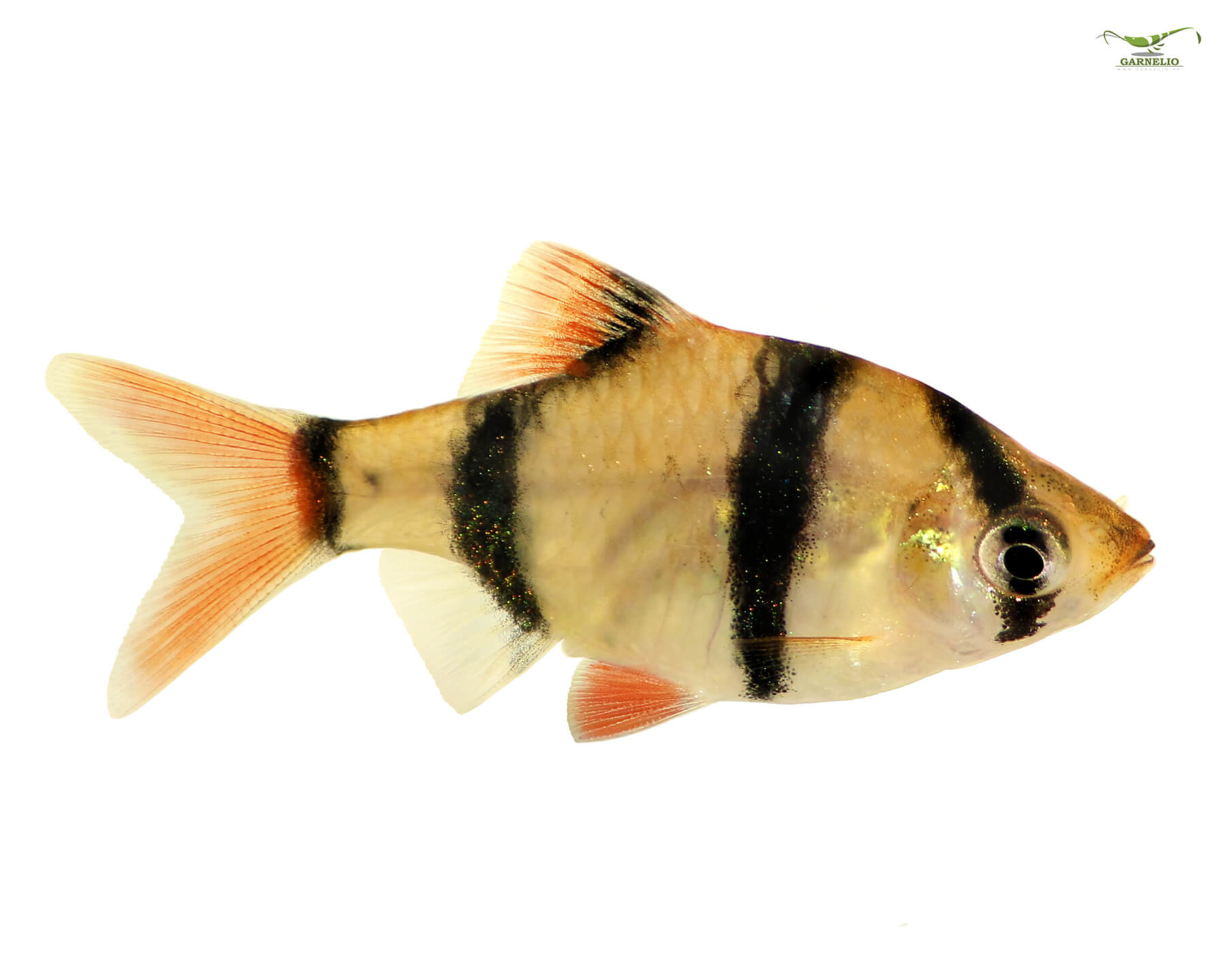
Moss barb - Barbus tetrazona -(Shop)
Colour form of the Sumatran barb. From Borneo and Sumatra, Indonesia. 6 cm large, lively, lively fish, for aquariums from 100 l. Breeding relatively easy. Omnivorous. Water values: GH 5-19° dGH, KH 3-17° dKH, pH 6.0-7.5, temperature 22-26°C.
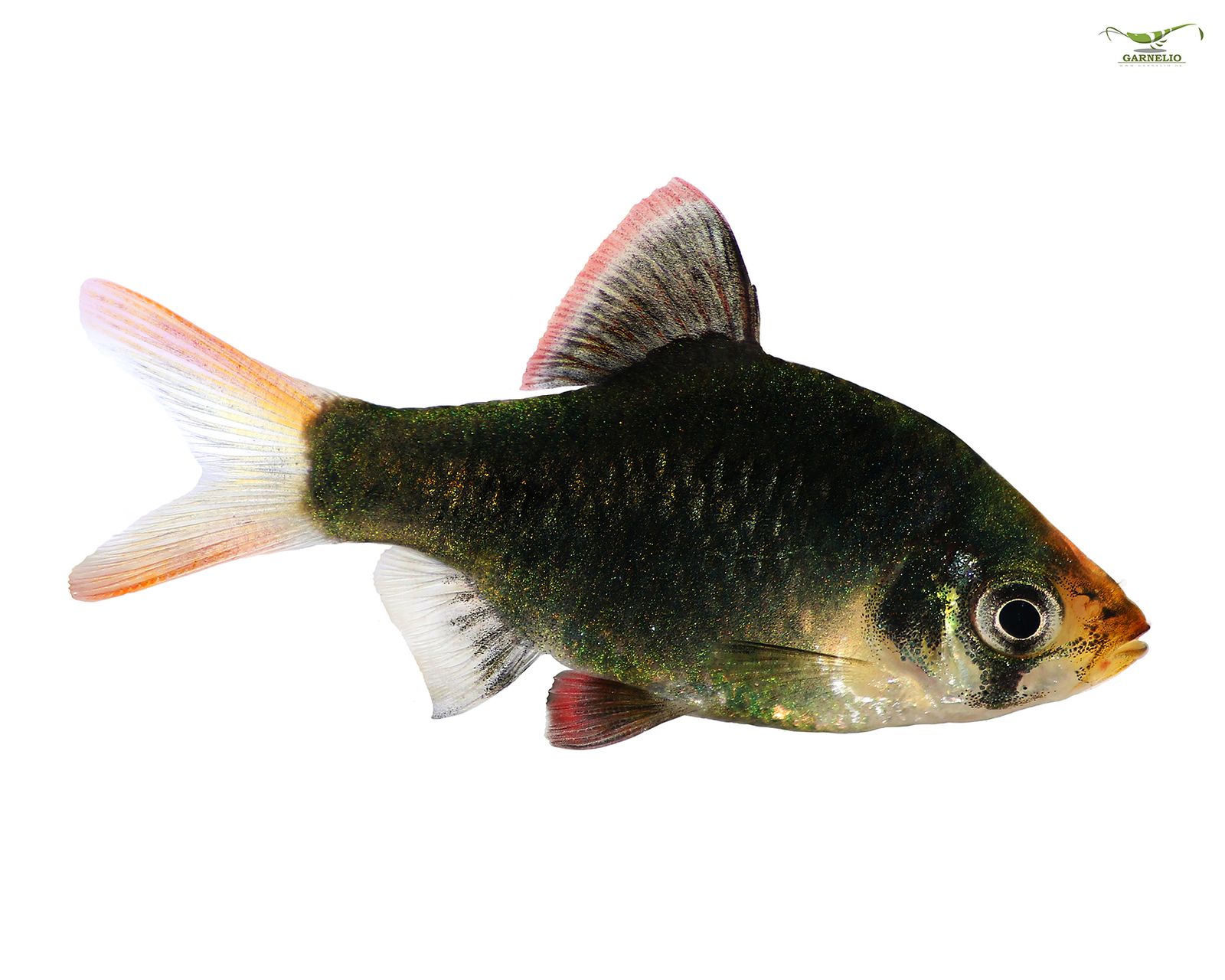
Sumatran barb "gold" - Barbus tetrazona -(Shop)
Colour form of the Sumatran barb. From Borneo and Sumatra, Indonesia. 6 cm large, lively, lively fish, for aquariums from 100 l. Breeding relatively easy. Omnivorous. Water values: GH 5-19° dGH, KH 3-17° dKH, pH 6.0-7.5, temperature 22-26°C.
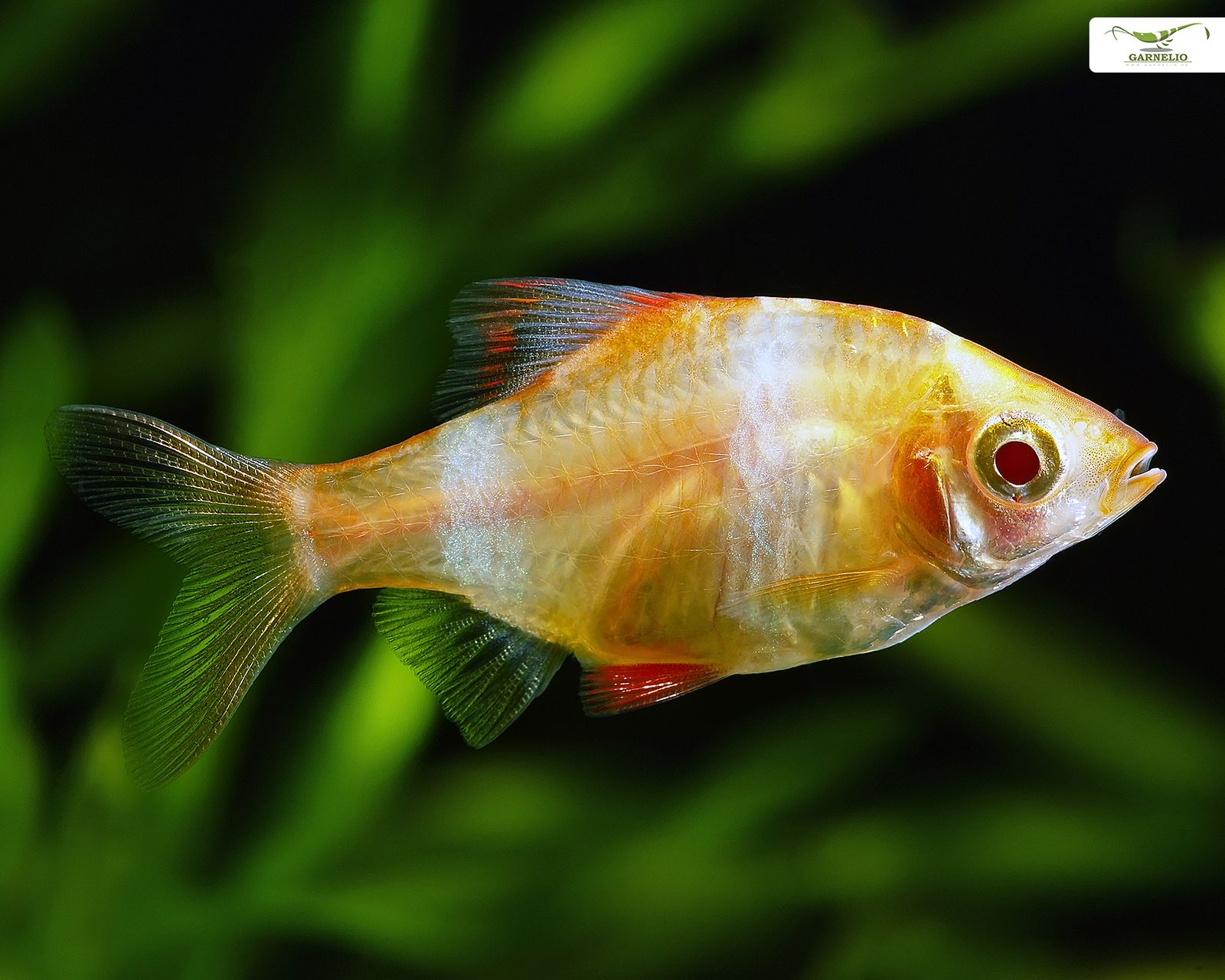
Sumatran barb "platinum-turquoise" - Barbus tetrazona -(Shop)
Colour form of the Sumatran barb. From Borneo and Sumatra, Indonesia. 6 cm large, lively, lively fish, for aquariums from 100 l. Breeding relatively easy. Omnivorous. Water values: GH 5-19° dGH, KH 3-17° dKH, pH 6.0-7.5, temperature 22-26°C.

Sumatran barb "gold-blue" - Barbus tetrazona -(Shop)
Colour form of the Sumatran barb. From Borneo and Sumatra, Indonesia. 6 cm large, lively, lively fish, for aquariums from 100 l. Breeding relatively easy. Omnivorous. Water values: GH 5-19° dGH, KH 3-17° dKH, pH 6.0-7.5, temperature 22-26°C.

Purple head barb - Pethia nigrofasciata -(Shop)
From Sri Lanka. 6 cm large, lively, lively fish, for aquariums from 100 l. Breeding moderately difficult. Omnivorous. Water values: Total hardness 5-12° dGH, KH 0-4 dKH, pH up to 6.0, temperature 22- 26°C.
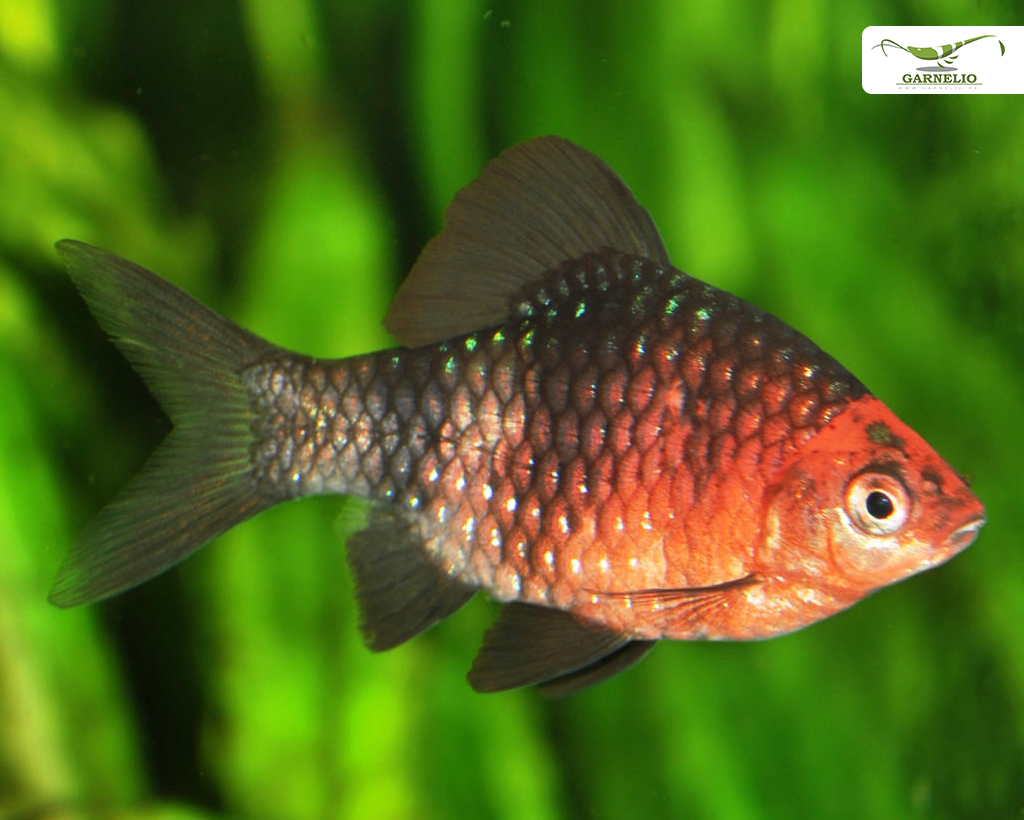
Brocade barb - Barbodes semifasciolatus -(Shop)
From China and Vietnam. 6 cm large, lively, lively fish, for aquariums from 150 l. Breeding moderately difficult. Omnivorous, mainly vegetable food. Water values: GH 4-20 °dGH, KH 2-15, pH 6-8, temperature 18-24°C.

Five-belted barb - Barbus pentazona -(Shop)
From Southeast Asia. 6 cm large, lively, lively fish, for aquariums from 150 l. Breeding relatively easy. Omnivorous. Water values: GH 5-12° dGH, KH 0-4 dKH, pH 5.5-6.8, temperature 24-27°C.
Bitterling barb - Puntius titteya -(Shop)
From Sri Lanka. 5 cm large, peaceful fish, for aquariums from 60 l. Breeding relatively easy. Omnivorous. Water values: GH 2-20, KH 6-15, pH 6.5-7, temperature 24-27° C.
Schleier Prachtbarbe - Barbus conchonius -(Shop)
From Southeast Asia. 10 cm large, lively, lively fish, for aquariums from 100 l. Breeding relatively easy. Omnivorous with emphasis on animal food. Water values: GH 6-30, KH 6-15, pH 6-10, temperature 18-25°C.
Red Lipstick Barb - Pethia erythromycter -(Shop)
From Myanmar. 4 cm large, peaceful, lively fish, for aquariums from 60 l. Breeding relatively easy. Omnivorous. Water values: GH 5 to 20, pH 6-7, temperature 20 to 26 °C.
Odessa Cormorant - Puntius padamya -(Shop)
From Myanmar. 5 cm large, lively, lively fish, for aquariums from 80 l upwards. Breeding relatively easy. Omnivorous. Water values: GH 0-20, KH 6-15, pH 6-10, temperature 18-27°C.
Eiland barb - Puntius oligolepis -(Shop)
From Indonesia. 4.5 cm large, lively, lively fish, for aquariums from 80 l. Breeding relatively easy. Omnivorous with emphasis on animal food. Water values: GH 1 to 8, KH 0 to 5, pH 5.5 to 7.5, temperature 18 to 25 °C.
Rhombus barb - Desmopuntius rhomboocellatus -(Shop)
From India. 7.5 cm large, lively, lively fish, for aquariums from 80 l. Breeding relatively easy. Omnivorous. Water values: GH 5 to 15, pH 6.5 to 7.5, temperature 22 to 28 °C.
Shark Cormorant - Balantiocheilus melanopterus -(Shop)
From Indonesia, Thailand, Cambodia. 40 cm large, lively, lively fish, for aquaria from 500 l. Breeding unknown. Omnivorous. Water values: GH 2 to 5, pH 6 to 8, temperature 22 to 27 °C.
Kangal Nibbler - Garra rufa -(Shop)
From the Middle East. Known from cosmetics, likes to eat skin flakes. 14 cm large, lively, lively fish, for aquariums from 250 l. Breeding relatively easy. Omnivorous. Water values: GH 3 to 22, KH 3 to 18, pH 6 to 8, temperature 24 to 28 °C.
Algae-eating barbs
Red-stripe algae eater - Puntius denisonii -(Shop)
From India. 12-15 cm large, lively, lively fish, for aquaria from 200 l. Breeding difficult. Omnivorous, eats algae. Water values: GH up to 20, KH 0-4, pH 6.5-7.5, temperature 24-28°C.
Proboscis barb - Crossocheilus siamensis -(Shop)
From Thailand. 15 cm large, lively, lively fish, for aquariums from 180 l. Breeding unknown. Omnivorous, eats algae. Water values: GH 2-20, KH 6-15, pH 6.5-7.5, temperature 24-26°C.
Magnificent algae eater - Garra flavatra -(Shop)
From Myanmar. 10 cm large, lively, lively fish, for aquaria from 200 l. Breeding relatively easy. Omnivorous, eats algae. Water values: GH 2-20, KH 6-15, pH 6.5-7.5, temperature 24-26°C.
Net Brush Algae Eater - Crossocheilus reticulatus -(Shop)
From Southeast Asia. 18 cm large, peaceful and lively fish, for aquariums from 400 l. Breeding unknown. Herbivore, algae eater. Water values: GH 5-15, pH 5-8, temperature 22-27°C.
The most popular species of danios or rasboras in aquaristics
Zebra danio - Brachydanio rerio -(Shop)
From Pakistan, India, Bangladesh. 6 cm in size, peaceful and lively fish, for aquariums from 120 l upwards. Easy to breed. Omnivorous. Water values: GH 5 to 20, KH 3 to 15, pH 6 to 7.5, temperature 18 to 25 °C.
Zebra danio "veil" - Brachydanio rerio -(Shop)
Veil form of the zebra danio. From Pakistan, India, Bangladesh. 6 cm large, peaceful and lively fish, for aquariums from 120 l upwards. Easy to breed. Omnivorous. Water values: GH 5 to 20, KH 3 to 15, pH 6 to 7.5, temperature 18 to 25 °C.
Leopard danio - Brachydanio frankei -(Shop)
Possibly a breeding form of the zebra danio, origin unclear. 6 cm in size, peaceful and lively fish, for aquaria from 120 l upwards. Easy to breed. Omnivorous. Water values: GH 10-30, KH 8-15, pH 6.5-8.5, temperature 24-27°C.
Veiled leopard danio - Brachydanio frankei "long fin" -(Shop)
Veil form of the Leopard danio. Possibly a breeding form of the zebra danio, origin unclear. 6 cm in size, peaceful and lively fish, for aquaria from 120 l upwards. Easy to breed. Omnivorous. Water values: GH 10-30, KH 8-15, pH 6.5-8.5, temperature 24-27°C.
Wedge barb - Trigonostigma heteromorpha -(Shop)
From Southeast Asia. 4.5 cm large, peaceful and lively fish, for aquariums from 60 l. Breeding possible. Omnivorous, needs frozen and live food. Water values: GH 5 to 10, KH 0 to 5, pH 6 to 7, temperature 22 to 26 °C.
Cardinalfish - Tanichthys albonubes -(Shop)
From South China. 5 cm large, peaceful and lively fish, for aquariums from 60 l. Breeding possible. Omnivorous, needs frozen and live food. Water values: GH 2-20, KH 2-15, pH 6-7.5, temperature 18-22°C.
Cardinalfish "veil" - Tanichthys albonubes "long fin" -(Shop)
Veil form of the Cardinalfish. From South China. 5 cm large, peaceful and lively fish, for aquariums from 60 l. Breeding possible. Omnivorous, needs frozen and live food. Water values: GH 2-20, KH 2-15, pH 6-7.5, temperature 18-22°C.
Cardinalfish "gold" - Tanichthys albonubes -(Shop)
Colour form of the Cardinalfish. From South China. 5 cm large, peaceful and lively fish, for aquariums from 60 l. Breeding possible. Omnivorous, needs frozen and live food. Water values: GH 2-20, KH 2-15, pH 6-7.5, temperature 18-22°C.
Cardinalfish "gold-orange" - Tanichthys albonubes -(Shop)
Colour form of the cardinal fish. From South China. 5 cm large, peaceful and lively fish, for aquariums from 60 l. Breeding possible. Omnivorous, needs frozen and live food. Water values: GH 2-20, KH 2-15, pH 6-7.5, temperature 18-22°C.
Malabar danio - Danio malabaricus -(Shop)
From India and Sri Lanka. 10 cm large, peaceful and lively fish, for aquariums from 120 l. Breeding possible. Omnivorous, needs frozen and live food. Water values: GH 6 to 15, pH 6.5 to 7, temperature 21 to 25 °C.
Red-tailed danio - Rasbora borapetensis -(Shop)
From Southeast Asia. 5 cm in size, peaceful and lively fish, for aquariums from 60 l. Breeding possible. Omnivorous, needs frozen and live food. Water values: GH 5 to 12, KH 0 to 8, pH 6 to 7.5, temperature 22 to 26 °C.
Dwarf danios
Dwarf danio - Boraras maculatus -(Shop)
From Sumatra. 2.5 cm large, peaceful sociable fish, for aquariums from 60 l. Breeding possible. Omnivorous, needs frozen and live food. Water values: GH 3 to 10, KH 0 to 6, pH 6 to 7, temperature 24 to 28 °C.
Tail stripe danio - Boraras urophthalmoides -(Shop)
From Southeast Asia. 2.5 cm large, peaceful sociable fish, for aquaria from 60 l. Breeding possible. Omnivorous, needs frozen and live food. Water values: GH 3 to 10, KH 0 to 5, pH 5 to 7.5, temperature 22 to 26 °C.
Gold spotted dwarf danio - Boraras merah -(Shop)
From Borneo, Indonesia. 2,5 cm large, peaceful sociable fish, for aquaria from 60 l. Breeding possible. Omnivorous, needs frozen and live food. Water values: GH 3 to 10, KH 0 to 6, pH 6 to 7, temperature 24 to 28 °C.
Mosquitorasbora - Boraras brigittae -(Shop)
From Borneo, Indonesia. 2.5 cm large, peaceful sociable fish, for aquariums from 60 l. Breeding possible. Omnivorous, needs frozen and live food. Water values: GH 3 to 10, KH 0 to 6, pH 6 to 7, temperature 24 to 28 °C.
Strawberry dwarf danio - Boraras naevus -(Shop)
From Thailand. 2.5 cm large, peaceful sociable fish, for aquariums from 60 l. Breeding possible. Omnivorous, needs frozen and live food. Water values: GH 3 to 10, KH 0 to 5, pH 5 to 7.5, temperature 22 to 26 °C.
Glow-eyed danio - Brevibora dorsiocellata -(Shop)
From Malaysia. 3.5 cm large, peaceful sociable fish, for aquaria from 60 l. Breeding possible. Omnivorous, needs frozen and live food. Water values: GH 5 to 10, KH 0 to 6, pH 5.5 to 7.5, temperature 24 to 25 °C.
Guinea fowl - Danio margaritatus -(Shop)
From Myanmar and Thailand. 3 cm large, peaceful sociable fish, for aquaria from 60 l. Breeding possible. Omnivorous, needs frozen and live food. Water values: GH 5-20, KH 3-20, pH 7-7.5, temperature 19-25
Cross-striped dwarf danio - Danio erythromicron -(Shop)
From Myanmar. 3 cm large, peaceful sociable fish, for aquariums from 60 l. Breeding possible. Omnivorous, needs frozen and live food. Water values: GH 5-20, KH 3-18, pH 7-8, temperature 18-25
Espesbarbe - Trigonostigma espei -(Shop)
From Thailand and Cambodia. 3 cm large, peaceful sociable fish, for aquariums from 60 l. Breeding possible. Omnivorous, needs frozen and live food. Water values: GH 3 to 15, KH 0 to 10, pH 6 to 7.5, temperature 22 to 28 °C.
Green Neon Dwarf Grassbora - Microdevario kubotai -(Shop)
From Thailand and Myanmar. 3.5 cm large, peaceful sociable fish, for aquaria from 60 l. Breeding possible. Omnivorous, needs frozen and live food. Water values: GH 1°-20° dGH, KH 0-8° dKH, pH 6.0-7.2, temperature 22°-26° C.
